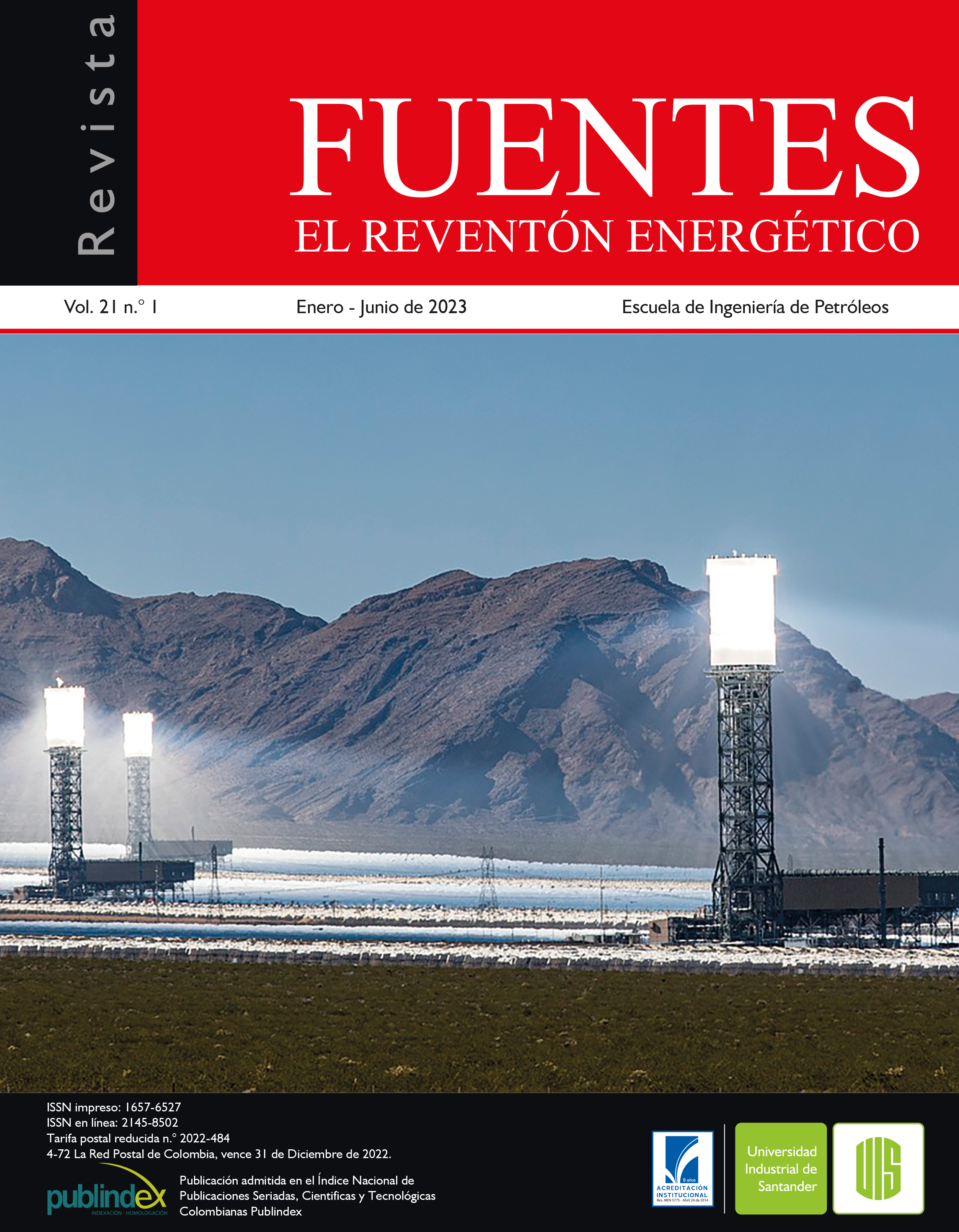STOCHASTIC NUMERICAL SIMULATION OF IN-DEPTH WATER CONFORMANCE CONTROL USING THERMALLY ACTIVE POLYMERS TREATMENTS
Published 2023-06-07
Keywords
- Waterflooding,
- In-depth water conformance,
- Thermally active polymer,
- Reservoir numerical simulation,
- Technical-financial analysis
How to Cite

This work is licensed under a Creative Commons Attribution 4.0 International License.
Abstract
Thermally active polymer (TAP) technology is used in reservoirs with waterflooding processes where preferential flow channels have been identified. This paper describes the main mechanisms associated with the TAP technology used in recovery processes for in-depth water conformance. Additionally, a study of the main laboratory tests recommended in the state of the art is carried out, and the most relevant parameters obtained from the fluid-fluid and rock-fluid experimental study of the TAP formulations
are analyzed.
Subsequently, a conceptual model of stochastic numerical simulation of reservoirs is built where a chemical reaction model is incorporated that is fed with parameter ranges such as concentration and viscosity of TAP polymer, accessible pore volume (VPA), adsorption, resistance factor (RF), and residual resistance factor (RRF), together with operating parameters such as injection
rate, slug-volume, and polymer cost, obtained from the literature, to perform a sensitivity analysis that allows identifying the
parameters that have the greatest impact on the performance of the in-depth water conformance treatments on the increase of the recovery factor and its financial indicators.
Downloads
References
- Al Bahri, M.S., Vazquez, O., Beteta, A., Al Kalbani, M.M., & Mackay, E. J. (2020, June). Modelling the Impact of Low Salinity Waterflooding, Polymer Flooding and Thermally Activated Polymer on Produced Water Composition. SPE International Oilfield Scale Conference and Exhibition. OnePetro. https://onepetro.org/SPEOSS/proceedings-abstract/20OSS/1-20OSS/D012S008R011/448660
- Daza, J., Castro. R. “Evaluación técnico-financiera de los pilotos IOR/EOR ejecutados en Colombia con tecnología de inyección de polímero HPAM”. Acipet, Cartagena, Colombia, 2022. https://www.researchgate.net/publication/363185029_Evaluacion_tecnico-financiera_de_los_pilotos_IOREOR_ejecutados_en_Colombia_con_tecnologia_de_inyeccion_de_polimero_HPAM
- Garmeh, R., Izadi, M., Salehi, M., Romero, J. L., Thomas, C. P., & Manrique, E. J. (2012). Thermally active polymer to improve sweep efficiency of waterfloods: simulation and pilot design approaches. SPE Reservoir Evaluation & Engineering, 15(01), 86-97. https://onepetro.org/REE/article-abstract/15/01/86/204561/Thermally-Active-Polymer-To-Improve-Sweep?redirectedFrom=fulltext
- Gómez, J. E., Iuliano, A., Martínez, C. (2020). Inyección de partículas activadas térmicamente en fondo para el control de conformance en profundidad para mejorar la recuperación de petróleo en un campo maduro de explotación secundaria: Cerro Dragón. 7° Congreso de Producción y Desarrollo de Reservas, realizado por el IAPG. https://www.petrotecnia.com.ar/120/Petro_archivos/Inyeccion.pdf
- Goudarzi, A. (2015). Modeling conformance control and chemical EOR processes using different reservoir simulators (Doctoral dissertation). The University of Texas libraries, 1-415. https://repositories.lib.utexas.edu/handle/2152/31338
- Granado, C., V (2012). Seminario virtual (webinar) Metodología para la selección en la estrategia óptima de la inyección polimérica de laboratorio a campo. https://youtu.be/WGiWkLI7pY4
- Gutierrez M., Garcia J., Castro R., Zafra T., Rojas J., Ortiz R., Quintero H., Garcia H., Niño L., Amado J., Quintero D., Kiani M. (2022). In-Depth Water Conformance Control: Design, Implementation and Surveillance of the First Thermally Active Polymers Treatment TAP in a Colombian Field. Paper presented at the SPE Improved Oil Recovery Conference, Virtual. https://onepetro.org/SPEIOR/proceedingsabstract/22IOR/1-22IOR/D011S007R002/484037
- H. Frampton, J. C. Morgan, S. K. Cheung, L. Munson, K. T. Chang & D. Williams. Development of a novel waterflood conformance control system. SPE paper 89391 presented at the 2004 SPE/DOE Fourteenth Symposium on Improved Oil Recovery held in Tulsa, Oklahoma, U.S.A., 17–21 April 2004. https://onepetro.org/SPEIOR/proceedingsabstract/04IOR/All-04IOR/SPE-89391-MS/71292
- Lugo, N., May, D., Campbell, E., Ng, R., Cheung, S., Offshore field experience with Brightwater®. Work Shop Water based EOR Diversion techniques in Stavanger, Norway, January 20th 2010. https://www.yumpu.com/en/document/view/38799782/offshore-field-experience-with-bright-water-force
- Martinez, R. E. (2001). Forecast techniques for lifting cost in gas and oil onshore fields. SPE Latin American and Caribbean Petroleum Engineering Conference. OnePetro. https://onepetro.org/SPELACP/proceedings-abstract/01LACPEC/All01LACPEC/SPE-69559-MS/133431
- Maya, G., Jimenez, R., Castro, R., Mantilla, J., Vargas, J., Cardenas, F., Fernandez, F., Quintero, H., Zaitoun, A., Manrique, E., Romero, J., Putnam, J., (2015). Design and Implementation of the First Polymer Flooding Project in Colombia: Yariguí-Cantagallo Field. Paper presented at the SPE-177245-MS Latin American and Caribbean Petroleum Engineering Conference. https://onepetro.org/SPELACP/proceedings-abstract/15LACP/1-15LACP/D011S004R001/184210
- Ohms, D., McLeod, J., Graff, C., Frampton, H., Morgan, J., Cheung, S., Yancey, K., Chang, K., “Incremental-Oil Success From Waterflood Sweep Improvement in Alaska”. Paper SPE-121761- MS. SPE International Symposium on Oilfield Chemistry, The Woodlands. Texas, April 2009.
- Pinto, M. S., Herrera, D. M., & Angarita, J. C. G. (2018). Optimización de la producción para un campo conceptual a través del uso combinado de inyección de polímero y tecnología de pozo inteligente. Fuentes: El reventón energético, 16(1), 37-45.
- Pritchett, J., Frampton, H., Brinkman, J., Cheung, S., Morgan, J., Chang, K. T., ... & Goodgame, J. (2003). Field application of a new in-depth waterflood conformance improvement tool. Paper presented at the SPE International Improved Oil Recovery Conference in Asia Pacific, Kuala Lumpur, Malaysia. https://onepetro.org/SPEAPIOR/proceedings-abstract/03IIORC/All03IIORC/SPE-84897-MS/137879
- Salehi, M., Thomas, C. P., Kevwitch, R. M., Manrique, E., Garmeh, R., & Izadi, M. (2012). Performance evaluation of thermally activated polymers for conformance correction applications. Paper presented at the SPE Improved Oil Recovery Symposium, Tulsa, Oklahoma, USA. https://onepetro.org/SPEIOR/proceedingsabstract/12IOR/All-12IOR/SPE-154022-MS/157954
- Vanegas, P. A. V., Ruiz, T. Y. Z., Macualo, F. H. E., & Martin, C. A. G. (2019). Metodología para la formulación de proyectos de recuperación química mediante analogías.
